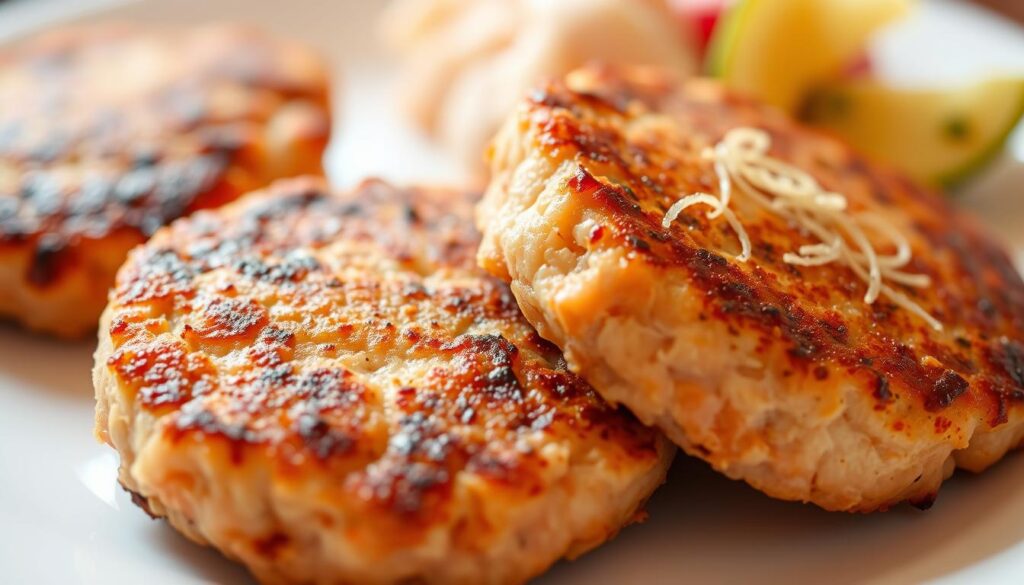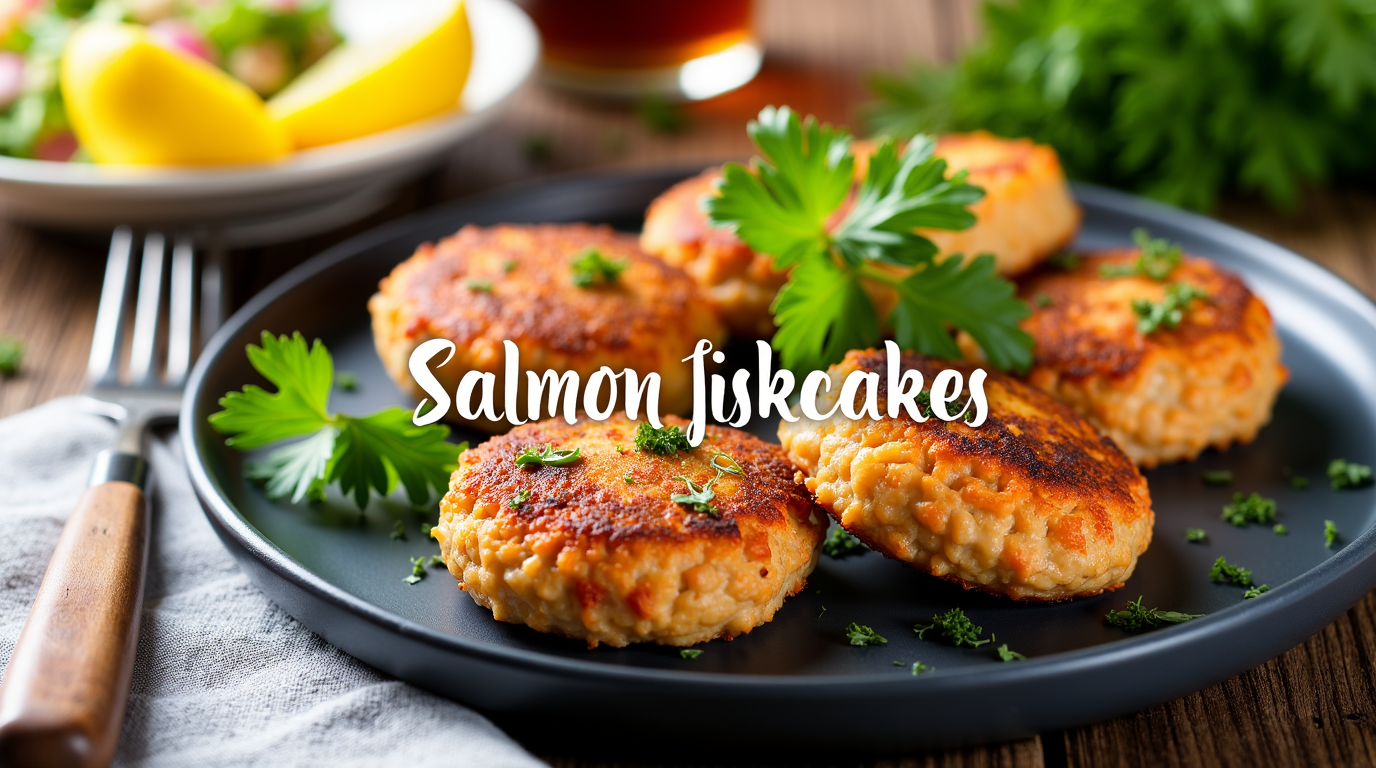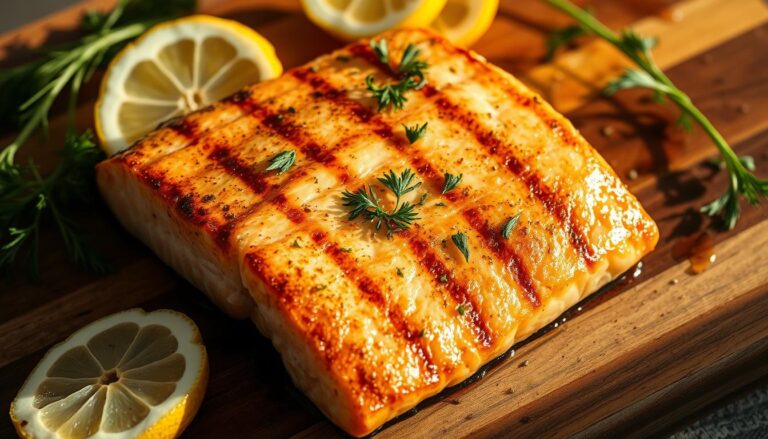Salmon Fishcakes: How to Make Perfect Patties in 5 Steps
Salmon fishcakes are more than just a meal—they are a bite of comfort, a taste of home, and a celebration of flavor. With their crispy golden crust and tender, flaky salmon filling, each bite is a perfect balance of texture and taste. The rich, savory notes of salmon blend beautifully with creamy potatoes, fragrant herbs, and a touch of seasoning, creating a dish that feels both hearty and elegant.
Table of Contents
Essential Ingredients for Perfect Salmon Fishcakes
To make delicious salmon fishcakes, you need the right ingredients. Fresh and sustainable ingredients are key for healthy fishcakes. For 4 servings, you’ll need 1¼ lb of skinless salmon fillet, 1¼ cups of panko bread crumbs, and ¼ cup of mayonnaise.
You’ll also need 1 tablespoon of fresh lemon juice, 1 teaspoon of Dijon mustard, and 1 teaspoon of Old Bay seasoning. These ingredients will help you create tasty quick salmon fishcakes.
Don’t forget some scallions, celery, and fresh dill. You’ll need about ¼ cup of thinly sliced scallions, ⅓ cup of finely diced celery, and 2 tablespoons of fresh dill. These add flavor and texture to your healthy salmon fishcakes.
For frying, you’ll need about ½ cup of vegetable oil. With these ingredients, you can make healthy salmon fishcakes that are both delicious and nutritious. The salmon, panko bread crumbs, and spices will give you a crispy outside and a tender inside. Your delicious salmon fishcakes will be a hit with everyone.
Here is a list of the essential ingredients you will need:
- 1¼ lb skinless salmon fillet
- 1¼ cups panko bread crumbs
- ¼ cup mayonnaise
- 1 tablespoon fresh lemon juice
- 1 teaspoon Dijon mustard
- 1 teaspoon Old Bay seasoning
- Scallions, celery, and fresh dill
- Vegetable oil for frying
Kitchen Tools and Equipment You’ll Need
the right utensils matter a lot. A food processor or blender can chop the salmon and mix the ingredients. A measuring cup and spoons help you get the right amounts. For an easy salmon cakes recipe, a cookie scoop is great for shaping patties.
- A cutting board for chopping the salmon and other ingredients
- A bowl for mixing the ingredients together
- A plate for serving the finished salmon fishcakes
Preparing Your Salmon: Fresh vs. Canned Options
To start, you can use either fresh or canned salmon. If you pick fresh, cut it into small pieces, about 1/4 inch thick. For canned salmon, just drain the liquid and use it as is. Here are some tips for preparing your salmon:
- Choose high-quality wild-caught salmon fillets for the best taste and to help the environment.
- Look for firm, moist fillets without a strong fishy smell.
- Use leftover fresh salmon to cut down on waste and make the most of your ingredients.

| Ingredient | Quantity |
|---|---|
| Salmon | 2 lbs (skinless, boneless) |
| Panko breadcrumbs | 4 Tablespoons |
| Egg | 1 egg, lightly beaten |
| Mayonnaise | 2 Tablespoons |
The Perfect Salmon Fishcakes: Step-by-Step Guide
To make the best salmon fishcakes, follow a few simple steps. Start by preparing your salmon, which can be fresh or canned. Make sure it’s flaked and mixed with the right ingredients for a delicious fishcake.
Next, prepare the potato base, a key part of any fishcake. Boil and mash potatoes, then mix them with the salmon and other ingredients. This mixture should be easy to shape into patties, perfect for quick salmon fishcakes.
Preparing the Salmon
Preparing the salmon is the first step. You can use fresh or canned salmon. If using canned, drain the liquid and flake it. If using fresh, cook it and then flake it.
Making the Potato Base
Making the potato base is the next step. Boil and mash 2-3 large potatoes. Then, mix them with the salmon and other ingredients. The mixture should be easy to shape into patties.
Mixing and Seasoning
Mixing and seasoning the salmon and potato mixture is key. Add salt, pepper, and any other seasonings you like. You can also add chopped onions or herbs for extra flavor.
Shaping the Patties
Shaping the patties is the final step before cooking. Use your hands to shape the mixture into small patties, about 1/2 inch thick. You should be able to make around 4-6 patties, depending on the size.
Cooking to Perfection
Cooking the salmon fishcakes to perfection is the last step. You can cook them in a frying pan with some oil, or bake them in the oven. Make sure they’re cooked through and golden brown on the outside. Serve hot and enjoy your delicious salmon fishcakes!
| Nutritional Information per serving | Amount |
|---|---|
| Calories | 317 kcal |
| Carbohydrates | 57 g |
| Protein | 11 g |
| Fat | 5 g |
Sauce and Accompaniment Suggestions
Now that you’ve mastered the art of making perfect fishcakes, it’s time to think about the sauce and accompaniments. A good sauce can make all the difference in bringing out the flavors of your salmon patties. Consider serving your fishcakes recipe with a tangy tartar sauce, a refreshing green salad, or a side of garlic-infused asparagus.
Some popular side dish options to consider include:
- Roasted vegetables, such as Brussels sprouts or broccoli
- Steamed vegetables, like asparagus or green beans
- A hearty bowl of soup, such as creamy tomato or butternut squash
- A fresh garden salad with mixed greens and a light vinaigrette
When it comes to sauces, a classic tartar sauce is always a good choice. It’s made with mayonnaise, chopped pickles, and a squeeze of lemon juice. Or, you could try a lighter option like a lemon-dill sauce or a spicy aioli. Whatever you choose, pair it with a side dish that complements the flavors of your salmon fishcakes.

With so many options to choose from, you’re sure to find the perfect combination. So go ahead, get creative, and experiment with different sauces and accompaniments. Find your new favorite way to enjoy fishcakes recipe.
Common Mistakes to Avoid When Making Fishcakes
When making homemade salmon fishcakes, it’s key to avoid common mistakes. These can mess up the texture, flavor, and quality of your easy salmon cakes. Knowing these pitfalls and how to avoid them is crucial.
Some common mistakes to avoid include:
- Overmixing the fish mixture, which can lead to dense and tough fishcakes
- Not using the right amount of filler, such as panko or breadcrumbs, which can affect the texture of your homemade salmon fishcakes
- Cooking the fishcakes at the wrong temperature or for the wrong amount of time, which can result in undercooked or overcooked easy salmon cakes
To make the best salmon fishcakes, following a tested recipe is essential. Also, take your time to prepare the ingredients well. By avoiding these mistakes and using quality ingredients, you’ll make delicious homemade salmon fishcakes that will wow everyone.
| Mistake | Effect | Prevention |
|---|---|---|
| Overmixing | Dense and tough fishcakes | Mix ingredients gently and briefly |
| Incorrect filler ratio | Affects texture | Use the right amount of filler, such as panko or breadcrumbs |
| Incorrect cooking temperature or time | Undercooked or overcooked fishcakes | Cook at the right temperature and for the right amount of time |
Healthy Variations of Traditional Salmon Fishcakes
There are many ways to make healthy salmon fishcakes. You can make delicious salmon fishcakes that are both tasty and good for you. Try using almond flour or coconut flour instead of breadcrumbs for a low-carb option.
Using canned salmon is another smart choice. It’s easy to find and won’t break the bank. Adding chopped veggies like onions and bell peppers boosts the nutritional value.
Here are some tips for making healthy salmon fishcakes:
- Use fresh and sustainable ingredients whenever possible
- Choose low-carb ingredients to reduce the glycemic index
- Add healthy fats like olive oil or avocado oil to increase the nutritional value
By following these tips, you can make delicious and healthy salmon fishcakes for a quick meal. Whether you’re after quick salmon fishcakes or healthy salmon fishcakes, you have lots of options.
| Ingredient | Quantity | Calories |
|---|---|---|
| Salmon fillets | 300g | 180 |
| Potatoes | 500g | 110 |
| Butter | 2 tablespoons | 140 |
Storage and Reheating Tips
To keep your salmon fishcakes fresh and tasty, proper storage and reheating are key. Cooked salmon patties can be stored in an airtight container in the fridge for up to 3 days.
For reheating, you can use the microwave or oven. Reheat single servings in 30-second bursts in the microwave. Larger portions need about 10 minutes in a 375-degree F oven. To avoid drying, add a splash of water or cover with a damp paper towel.
Here are some extra tips for storing and reheating your salmon fishcakes:
- Flash freeze the patties for up to 3 months to keep their texture and flavor.
- Reheat frozen patties in the oven at 375 degrees F for about 10-12 minutes per side.
- Use a thermometer to check the internal temperature reaches 145 degrees F.
By following these tips, you can enjoy your salmon fishcakes for longer. Whether you make salmon patties or fishcakes, storing and reheating them right is important. It helps keep their quality and flavor.
| Storage Method | Duration | Reheating Method |
|---|---|---|
| Refrigerator | Up to 3 days | Microwave or oven |
| Freezer | Up to 3 months | Oven |
Make-Ahead and Freezing Instructions
Want to enjoy your homemade salmon fishcakes whenever you like? You can make them ahead and freeze them. This is perfect for busy days when you need a quick, tasty meal. Your easy salmon cakes can stay frozen for up to 3 months, making them ideal for meal prep.
Freezing your best salmon fishcakes right? It’s key to keep their quality and texture good. Here are some tips to remember:
- Place the fishcakes in a single layer on a baking sheet lined with parchment paper.
- Put the baking sheet in the freezer and let the fishcakes freeze for about 1-2 hours, or until they are frozen solid.
- Transfer the frozen fishcakes to an airtight container or freezer bag, making sure to label and date it.
To reheat your frozen homemade salmon fishcakes, just put them in an oven preheated to 180°C (160°C fan/gas mark 4/350°F) for about 15 minutes. They should be hot through. You can also pan-fry them with a bit of oil until they’re golden and crispy. With these tips, you can enjoy your easy salmon cakes whenever you want.
Conclusion: Mastering the Art of Salmon Fishcakes
Making the perfect salmon fishcakes is an art that needs attention to detail and creativity. You’ve learned how to pick the right ingredients and shape the patties just right. This way, you can make salmon patties that taste great and look good too.
FAQ
What is the history and evolution of salmon fishcakes?
What are the essential ingredients for making perfect salmon fishcakes?
What kitchen tools and equipment are needed to make salmon fishcakes?
Should I use fresh or canned salmon for my fishcakes?
What are the steps to make perfect salmon fishcakes?
What sauces and accompaniments pair well with salmon fishcakes?
What are the common mistakes to avoid when making salmon fishcakes?
Are there any healthy variations of traditional salmon fishcakes?
How should I store and reheat my salmon fishcakes?
Can I make salmon fishcakes ahead of time and freeze them?
Source Links
- Easy Homemade Salmon Fishcakes – https://www.therealmealdeal.com/salmon-fish-cakes/
- Easy Baked Salmon Cakes (Salmon Patties) to Share with the Kdis – https://www.yummytoddlerfood.com/wild-salmon-cakes/
- Easy salmon fishcakes – https://www.foodleclub.com/easy-salmon-fishcakes/
- Why Southerners Love The Simplicity Of Classic Salmon Patties – https://www.southernliving.com/recipes/salmon-patties?srsltid=AfmBOorwzIgU_DvVhMwA-YSxcPSdfYh5otTD4MQrqMXVka_yOf19GiD-
- Easy Salmon Cakes – https://www.eatingwell.com/recipe/248780/easy-salmon-cakes/
- Report: Seafood industry must adapt to younger consumers’ demand for convenience as at-home prepared foods sector booms – Responsible Seafood Advocate – https://www.globalseafood.org/advocate/report-seafood-industry-must-adapt-to-younger-consumers-demand-for-convenience-as-at-home-prepared-foods-sector-booms/
- Salmon Cakes Recipe – Once Upon a Chef – https://www.onceuponachef.com/recipes/salmon-cakes.html
- Easy Salmon Fishcakes (with tinned salmon!) – https://beatthebudget.com/recipe/salmon-fishcakes/
- Made With Fresh Salmon, I Could Eat 10 of These Delicious Patties at a Time! – https://www.thespruceeats.com/fresh-salmon-patties-recipe-1136232
- Easy Salmon Patties Recipe: Quick and Delicious Just in 10 min – https://www.deliciosorecipe.com/salmon-patties-recipe-2/
- How To Prevent Those Salmon Patties From Falling Apart – https://www.yahoo.com/lifestyle/prevent-those-salmon-patties-falling-191524289.html
- How To Make Salmon Patties (VIDEO) – https://www.olgasflavorfactory.com/recipes/weeknight-dinners/salmon-cakes/
- Easy Salmon Patties – with canned or fresh salmon! – https://theflattopking.com/salmon-patties/
- SALMON CAKES WITH FRESH SALMON – https://hiphipgourmet.com/salmon-cakes-with-fresh-salmon/
- Salmon Fishcake Recipe with Fresh Salmon – The Frugal Flexitarian – https://frugalflexitarian.com/salmon-fishcake-recipe-with-fresh-salmon/
- Salmon Fishcakes – https://healthylivingjames.co.uk/sweet-chilli-salmon-fishcakes/
- 25+ Sides for Fish Cakes – https://www.platingsandpairings.com/what-to-serve-with-fish-cakes/
- What To Serve With Fish Cakes? 20 Tasty Side Dishes – https://www.corriecooks.com/what-to-serve-with-fish-cakes/
- Tuscan Salmon with Parmesan Cream Sauce – https://vikalinka.com/tuscan-salmon-parmesan-cream-sauce/


